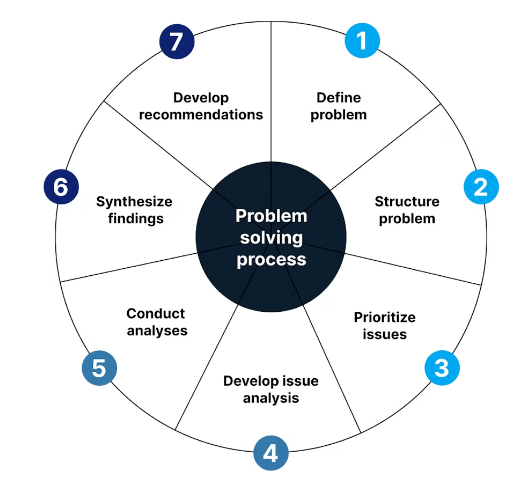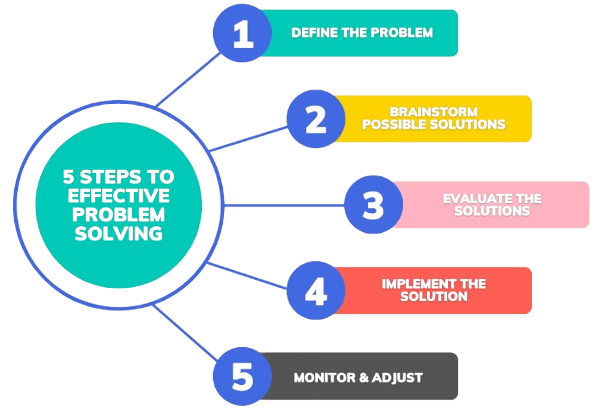
- Introduction
- What is a Problem-Solving Framework?
- The Importance of a Structured Approach to Problem-Solving
- Key Stages of the Problem-Solving Framework
- The Role of Creativity in Problem-Solving
- Problem-Solving Tools and Techniques
- Overcoming Challenges in Problem-Solving
- Conclusion
Introduction to Interpersonal Communication
Problem-solving is a vital skill in both personal and professional settings. Whether managing a team, leading a project, or tackling everyday challenges, having a structured approach can lead to more effective and sustainable solutions. This blog will explore various problem-solving frameworks, methods, and techniques designed to help you navigate obstacles with confidence. We will dive into key stages of the problem-solving process in PMP Training, including defining the problem, generating potential solutions, and implementing the best course of action. Additionally, we’ll examine standard models like the PDCA (Plan-Do-Check-Act) cycle and the 5 Whys, which help in breaking down complex issues. To improve your problem-solving abilities, we’ll discuss essential tools and techniques, such as root cause analysis and brainstorming. We’ll also address common challenges, like cognitive biases and information gaps, which can hinder clear thinking and decision-making. By applying these frameworks and methods, you can approach problems with greater clarity and resolve them more efficiently, ultimately making better decisions in both your personal and professional life.
Interested in Obtaining Your PMP Certificate? View The PMP Certification Training Offered By ACTE Right Now!
What is a Problem-Solving Framework?
A problem-solving framework is a systematic approach used to identify, analyze, and resolve issues. It provides a set of structured steps or guidelines that help individuals or teams tackle problems in an organized and efficient manner. By following a clear framework, people can ensure they consider all aspects of an issue before implementing a solution. A well-designed framework helps break down complex problems into smaller, more manageable tasks, fostering critical thinking and encouraging a thorough examination of all possible solutions in The Importance of Work Packages in Project Scope Management. This structured approach helps prevent impulsive decisions, ensures that solutions are based on data and evidence, and minimizes the risk of overlooking important factors.

Problem-solving frameworks are essential in various fields, including business, engineering, healthcare, education, and personal development. In business, for instance, they help organizations solve operational challenges, while in healthcare, they ensure that patient care issues are addressed effectively. By adhering to a logical, organized process, individuals and teams increase their chances of finding practical, lasting solutions, ultimately improving their decision-making and problem-solving abilities.
The Importance of a Structured Approach to Problem-Solving
- Clarity in Problem Definition: A structured approach helps clearly define the problem, preventing misinterpretation and ensuring that efforts are directed toward the actual issue.
- Systematic Analysis: It promotes a logical breakdown of the problem, allowing for thorough investigation and understanding of underlying causes.
- Efficient Use of Time and Resources: By following a step-by-step process, teams avoid wasting time and resources on irrelevant tasks or ineffective solutions in How to Get Project Management Experience for PMP Certification.
- Encourages Creativity and Innovation: Structured frameworks often include stages for idea generation, helping individuals think creatively and explore diverse solutions.
- Reduces Cognitive Biases: A methodical approach minimizes the impact of personal biases and assumptions, promoting objective and data-driven decisions.
- Improves Collaboration: Having a shared structure enhances communication and teamwork, ensuring everyone contributes effectively and stays aligned.
- Leads to Sustainable Solutions: By focusing on root causes and long-term outcomes, structured problem-solving results in solutions that are effective and lasting.
- Define the Problem: Clearly understanding and articulating the problem is the first step. Gather relevant information and identify the core issue. Recognizing symptoms that might obscure the root cause is essential for ensuring you’re addressing the right problem.
- Analyze the Problem: Break the problem into smaller, manageable parts. Look for patterns, data relationships, and context to identify underlying causes. This step is crucial to avoid addressing only superficial issues and ensure you’re tackling the root problem.
- Set Clear Objectives: Establish specific, measurable goals that you want to achieve with your solution. Whether it’s improving efficiency, reducing costs, or enhancing customer satisfaction, clear objectives guide your problem-solving efforts and help keep the team focused.
- Generate Possible Solutions: Brainstorm a range of solutions without immediate judgment. Encouraging creativity and openness helps generate innovative ideas. Collaborating with a diverse team can offer fresh perspectives and potentially uncover better solutions.
- Evaluate and Prioritize Solutions: Critically assess each possible solution in PMP Training. Evaluate factors such as feasibility, time, cost, and potential impact. Prioritize the solutions that align best with your goals and available resources.
- Implement the Solution: Put the chosen solution into action, following the planned steps. Monitor progress and stay in communication with all stakeholders. Be ready to adapt the plan as challenges arise during the implementation process.
- Develop an Action Plan: Once a solution is selected, create a detailed plan for its implementation. Define roles, responsibilities, timelines, and the resources needed. A well-structured action plan ensures that the solution is carried out efficiently and effectively.
- Review and Reflect: After implementing the solution, assess the results. Did it meet the objectives? Reflect on the process, noting what worked well and what didn’t. This reflection helps in learning from successes and mistakes, improving future problem-solving efforts.
- Brainstorming: This technique encourages the generation of a wide variety of ideas, without judgment, to explore potential solutions. It stimulates creativity and collaboration in group settings.
- Root Cause Analysis: This approach involves identifying the underlying cause of a problem rather than just addressing its symptoms. Techniques like the “5 Whys” can help dig deeper into issues.
- Mind Mapping: Mind maps visually organize information, helping to break down complex problems into manageable components and revealing connections between ideas or solutions.
- SWOT Analysis: This tool analyzes a situation’s Strengths, Weaknesses, Opportunities, and Threats, providing a comprehensive view that aids in strategic decision-making in Different Ways to Calculate the Estimate at Completion EAC.
- Fishbone Diagram: Also known as Ishikawa, this diagram helps to identify and analyze potential causes of a problem, categorizing them into different areas like people, processes, or equipment.
- The 5 Whys: By repeatedly asking “why” five times, this technique drills down into the cause-and-effect relationships that lead to the problem, uncovering its root cause.
- Trial and Error: Sometimes the best way to solve a problem is by testing different solutions, learning from mistakes, and refining approaches until the issue is resolved.
To Earn Your PMP Certification, Gain Insights From Leading Data Science Experts And Advance Your Career With ACTE’s PMP Certification Training Today!
Key Stages of the Problem-Solving Framework

The Role of Creativity in Problem-Solving
Creativity is crucial in problem-solving, especially when conventional methods fail to provide effective solutions. Creative thinking encourages individuals to think outside the box and generate innovative ideas that may not be immediately obvious. Tools like brainstorming and mind mapping are excellent for sparking creativity and developing unique solutions. Several problem-solving techniques can enhance the process. Mind mapping, for instance, helps visualize all aspects of a problem, including its components, relationships, and possible solutions, providing a structured approach to brainstorming in What Is a ScrumMaster. Brainstorming itself is an idea-generation technique that encourages open, judgment-free discussions within a group, often leading to creative and innovative outcomes. The Fishbone Diagram, or Ishikawa, helps identify the root causes of complex problems by categorizing contributing factors such as people, processes, and materials. It is especially useful for issues with multiple interrelated causes. Another valuable tool is SWOT analysis, which assesses internal and external factors Strengths, Weaknesses, Opportunities, and Threats that might impact a solution. This helps to evaluate both the advantages and risks before implementing a solution, ensuring a well-rounded approach to problem-solving.
Gain Your Master’s Certification in PMP by Enrolling in Our PMP Masters Program Training Course.
Problem-Solving Tools and Techniques
Overcoming Challenges in Problem-Solving
Problem-solving can be challenging, and several obstacles may interfere with finding effective solutions. One common issue is cognitive bias. Biases like confirmation bias where individuals favor information that supports their preexisting beliefs and anchoring where the first piece of information unduly influences decisions can cloud judgment. To mitigate these effects, it’s important to gather objective data, consider alternative viewpoints, and remain open to changing one’s perspective. Another major challenge in Top Highest Paying Tech Jobs in India is a lack of information. Making decisions without complete or accurate data can lead to ineffective or even harmful outcomes. Ensuring that you collect sufficient, reliable information before taking action is essential for sound decision-making. This might involve research, consulting experts, or verifying data sources. Lastly, the fear of failure can hinder progress. When people are afraid to make mistakes, they may delay action, avoid risks, or settle for safe but suboptimal solutions. To overcome this, it’s important to embrace failure as a learning opportunity. Encouraging a mindset focused on growth and continuous improvement can help individuals and teams move forward with greater confidence and creativity. Recognizing these common obstacles is the first step toward more effective problem-solving.
Preparing for a PMP Job Interview? Check Out Our Blog on Project Management Interview Questions & Answer
Conclusion
Problem-solving is a vital skill in every area of life, from personal situations to professional environments. Taking a structured approach can greatly improve both the efficiency and effectiveness of finding solutions. By using a clear framework, individuals and teams can approach challenges with greater clarity and purpose. Well-known methods like the IDEAL framework, the 5 Whys technique, and tools such as SWOT analysis and mind mapping offer valuable strategies for identifying root causes, analyzing situations, and generating possible solutions. These approaches in PMP Training promote a deeper understanding of the problem at hand and encourage creative, critical thinking. They also help ensure that decisions are based on thorough analysis rather than assumptions or guesswork. The key to effective problem-solving lies in staying focused, being open to different perspectives, and following a methodical process from start to finish. When individuals combine logical reasoning with the right tools, they are more likely to develop innovative, practical, and sustainable solutions. Ultimately, problem-solving is more than just a skill; it’s an opportunity for learning, growth, and continuous improvement. With the right mindset and approach, even the most complex challenges can become manageable and lead to lasting success.


